Leading Change: Organizational Strategy and Behaviour Analysis Report
VerifiedAdded on 2023/01/03
|11
|4136
|41
Report
AI Summary
This report delves into the critical aspects of understanding and leading change within organizations, utilizing H&M as a prominent case study. It examines the impact of change on an organization's strategy and operations, considering both internal and external change drivers such as political, economic, and technological factors. The report explores how these drivers influence organizational behavior, affecting teams, individuals, and leadership approaches. It analyzes measures for reducing the negative impacts of change, including effective leadership styles and the implementation of continuous improvement models like Six Sigma, the Theory of Constraints, Total Quality Management, and Lean methodologies. Furthermore, the report identifies barriers to change affecting decision-making within H&M and assesses different leadership approaches for effectively dealing with change, offering insights into fostering adaptability and sustainable growth in a dynamic business environment. The report is contributed by a student to Desklib, a platform providing AI-powered study tools.
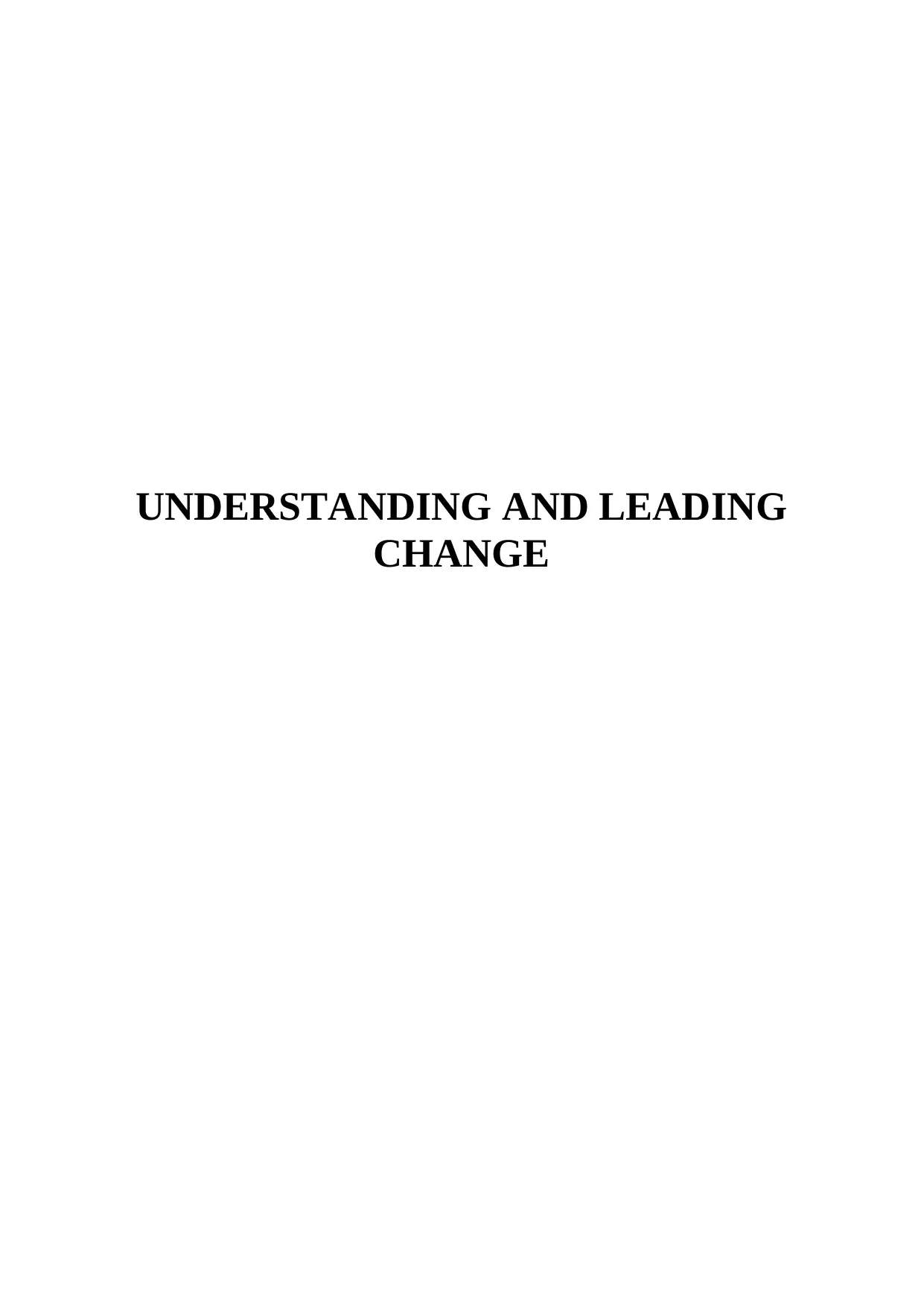
UNDERSTANDING AND LEADING
CHANGE
CHANGE
Paraphrase This Document
Need a fresh take? Get an instant paraphrase of this document with our AI Paraphraser
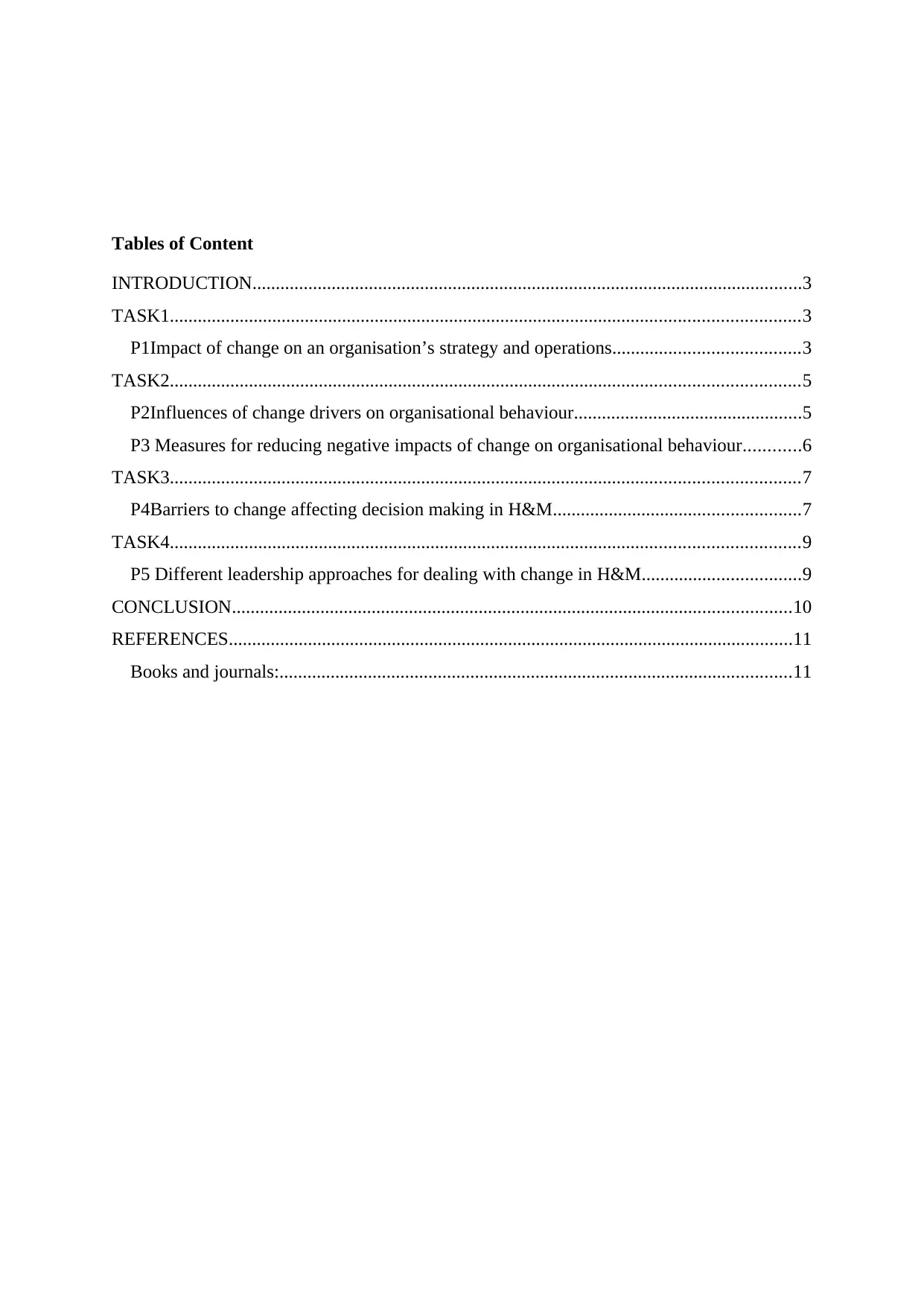
Tables of Content
INTRODUCTION......................................................................................................................3
TASK1.......................................................................................................................................3
P1Impact of change on an organisation’s strategy and operations........................................3
TASK2.......................................................................................................................................5
P2Influences of change drivers on organisational behaviour.................................................5
P3 Measures for reducing negative impacts of change on organisational behaviour............6
TASK3.......................................................................................................................................7
P4Barriers to change affecting decision making in H&M.....................................................7
TASK4.......................................................................................................................................9
P5 Different leadership approaches for dealing with change in H&M..................................9
CONCLUSION........................................................................................................................10
REFERENCES.........................................................................................................................11
Books and journals:..............................................................................................................11
INTRODUCTION......................................................................................................................3
TASK1.......................................................................................................................................3
P1Impact of change on an organisation’s strategy and operations........................................3
TASK2.......................................................................................................................................5
P2Influences of change drivers on organisational behaviour.................................................5
P3 Measures for reducing negative impacts of change on organisational behaviour............6
TASK3.......................................................................................................................................7
P4Barriers to change affecting decision making in H&M.....................................................7
TASK4.......................................................................................................................................9
P5 Different leadership approaches for dealing with change in H&M..................................9
CONCLUSION........................................................................................................................10
REFERENCES.........................................................................................................................11
Books and journals:..............................................................................................................11
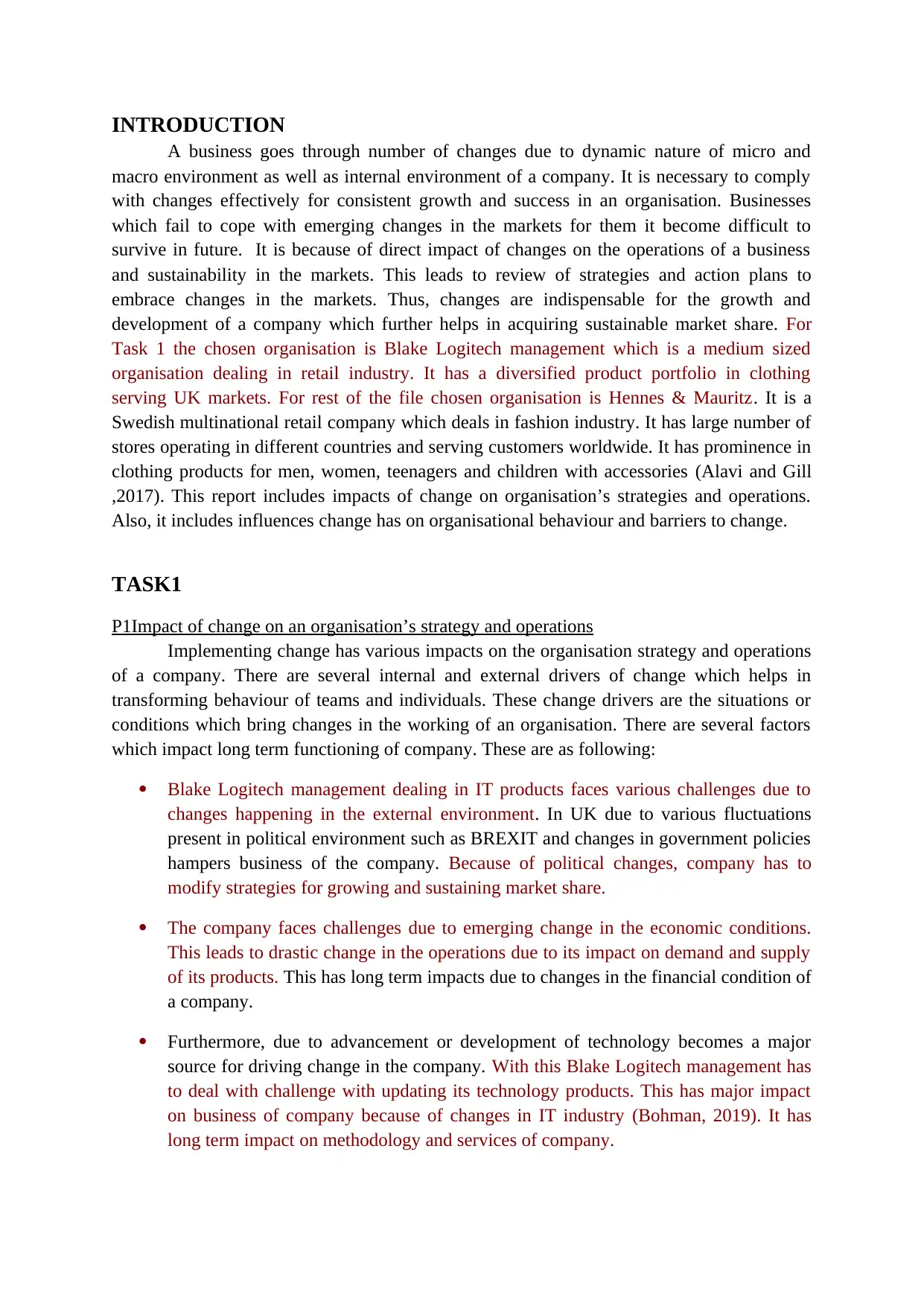
INTRODUCTION
A business goes through number of changes due to dynamic nature of micro and
macro environment as well as internal environment of a company. It is necessary to comply
with changes effectively for consistent growth and success in an organisation. Businesses
which fail to cope with emerging changes in the markets for them it become difficult to
survive in future. It is because of direct impact of changes on the operations of a business
and sustainability in the markets. This leads to review of strategies and action plans to
embrace changes in the markets. Thus, changes are indispensable for the growth and
development of a company which further helps in acquiring sustainable market share. For
Task 1 the chosen organisation is Blake Logitech management which is a medium sized
organisation dealing in retail industry. It has a diversified product portfolio in clothing
serving UK markets. For rest of the file chosen organisation is Hennes & Mauritz. It is a
Swedish multinational retail company which deals in fashion industry. It has large number of
stores operating in different countries and serving customers worldwide. It has prominence in
clothing products for men, women, teenagers and children with accessories (Alavi and Gill
,2017). This report includes impacts of change on organisation’s strategies and operations.
Also, it includes influences change has on organisational behaviour and barriers to change.
TASK1
P1Impact of change on an organisation’s strategy and operations
Implementing change has various impacts on the organisation strategy and operations
of a company. There are several internal and external drivers of change which helps in
transforming behaviour of teams and individuals. These change drivers are the situations or
conditions which bring changes in the working of an organisation. There are several factors
which impact long term functioning of company. These are as following:
Blake Logitech management dealing in IT products faces various challenges due to
changes happening in the external environment. In UK due to various fluctuations
present in political environment such as BREXIT and changes in government policies
hampers business of the company. Because of political changes, company has to
modify strategies for growing and sustaining market share.
The company faces challenges due to emerging change in the economic conditions.
This leads to drastic change in the operations due to its impact on demand and supply
of its products. This has long term impacts due to changes in the financial condition of
a company.
Furthermore, due to advancement or development of technology becomes a major
source for driving change in the company. With this Blake Logitech management has
to deal with challenge with updating its technology products. This has major impact
on business of company because of changes in IT industry (Bohman, 2019). It has
long term impact on methodology and services of company.
A business goes through number of changes due to dynamic nature of micro and
macro environment as well as internal environment of a company. It is necessary to comply
with changes effectively for consistent growth and success in an organisation. Businesses
which fail to cope with emerging changes in the markets for them it become difficult to
survive in future. It is because of direct impact of changes on the operations of a business
and sustainability in the markets. This leads to review of strategies and action plans to
embrace changes in the markets. Thus, changes are indispensable for the growth and
development of a company which further helps in acquiring sustainable market share. For
Task 1 the chosen organisation is Blake Logitech management which is a medium sized
organisation dealing in retail industry. It has a diversified product portfolio in clothing
serving UK markets. For rest of the file chosen organisation is Hennes & Mauritz. It is a
Swedish multinational retail company which deals in fashion industry. It has large number of
stores operating in different countries and serving customers worldwide. It has prominence in
clothing products for men, women, teenagers and children with accessories (Alavi and Gill
,2017). This report includes impacts of change on organisation’s strategies and operations.
Also, it includes influences change has on organisational behaviour and barriers to change.
TASK1
P1Impact of change on an organisation’s strategy and operations
Implementing change has various impacts on the organisation strategy and operations
of a company. There are several internal and external drivers of change which helps in
transforming behaviour of teams and individuals. These change drivers are the situations or
conditions which bring changes in the working of an organisation. There are several factors
which impact long term functioning of company. These are as following:
Blake Logitech management dealing in IT products faces various challenges due to
changes happening in the external environment. In UK due to various fluctuations
present in political environment such as BREXIT and changes in government policies
hampers business of the company. Because of political changes, company has to
modify strategies for growing and sustaining market share.
The company faces challenges due to emerging change in the economic conditions.
This leads to drastic change in the operations due to its impact on demand and supply
of its products. This has long term impacts due to changes in the financial condition of
a company.
Furthermore, due to advancement or development of technology becomes a major
source for driving change in the company. With this Blake Logitech management has
to deal with challenge with updating its technology products. This has major impact
on business of company because of changes in IT industry (Bohman, 2019). It has
long term impact on methodology and services of company.
⊘ This is a preview!⊘
Do you want full access?
Subscribe today to unlock all pages.

Trusted by 1+ million students worldwide
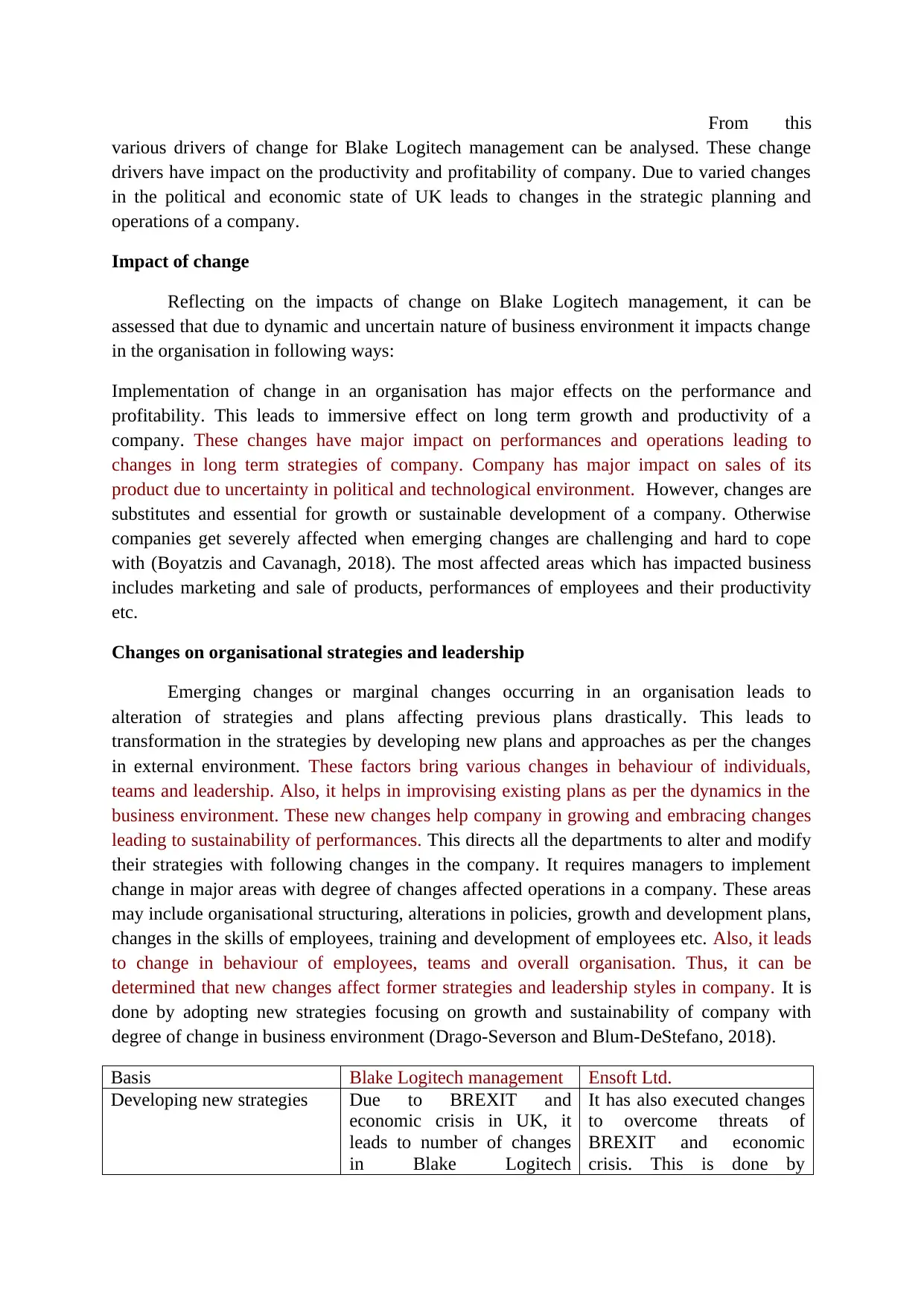
From this
various drivers of change for Blake Logitech management can be analysed. These change
drivers have impact on the productivity and profitability of company. Due to varied changes
in the political and economic state of UK leads to changes in the strategic planning and
operations of a company.
Impact of change
Reflecting on the impacts of change on Blake Logitech management, it can be
assessed that due to dynamic and uncertain nature of business environment it impacts change
in the organisation in following ways:
Implementation of change in an organisation has major effects on the performance and
profitability. This leads to immersive effect on long term growth and productivity of a
company. These changes have major impact on performances and operations leading to
changes in long term strategies of company. Company has major impact on sales of its
product due to uncertainty in political and technological environment. However, changes are
substitutes and essential for growth or sustainable development of a company. Otherwise
companies get severely affected when emerging changes are challenging and hard to cope
with (Boyatzis and Cavanagh, 2018). The most affected areas which has impacted business
includes marketing and sale of products, performances of employees and their productivity
etc.
Changes on organisational strategies and leadership
Emerging changes or marginal changes occurring in an organisation leads to
alteration of strategies and plans affecting previous plans drastically. This leads to
transformation in the strategies by developing new plans and approaches as per the changes
in external environment. These factors bring various changes in behaviour of individuals,
teams and leadership. Also, it helps in improvising existing plans as per the dynamics in the
business environment. These new changes help company in growing and embracing changes
leading to sustainability of performances. This directs all the departments to alter and modify
their strategies with following changes in the company. It requires managers to implement
change in major areas with degree of changes affected operations in a company. These areas
may include organisational structuring, alterations in policies, growth and development plans,
changes in the skills of employees, training and development of employees etc. Also, it leads
to change in behaviour of employees, teams and overall organisation. Thus, it can be
determined that new changes affect former strategies and leadership styles in company. It is
done by adopting new strategies focusing on growth and sustainability of company with
degree of change in business environment (Drago-Severson and Blum-DeStefano, 2018).
Basis Blake Logitech management Ensoft Ltd.
Developing new strategies Due to BREXIT and
economic crisis in UK, it
leads to number of changes
in Blake Logitech
It has also executed changes
to overcome threats of
BREXIT and economic
crisis. This is done by
various drivers of change for Blake Logitech management can be analysed. These change
drivers have impact on the productivity and profitability of company. Due to varied changes
in the political and economic state of UK leads to changes in the strategic planning and
operations of a company.
Impact of change
Reflecting on the impacts of change on Blake Logitech management, it can be
assessed that due to dynamic and uncertain nature of business environment it impacts change
in the organisation in following ways:
Implementation of change in an organisation has major effects on the performance and
profitability. This leads to immersive effect on long term growth and productivity of a
company. These changes have major impact on performances and operations leading to
changes in long term strategies of company. Company has major impact on sales of its
product due to uncertainty in political and technological environment. However, changes are
substitutes and essential for growth or sustainable development of a company. Otherwise
companies get severely affected when emerging changes are challenging and hard to cope
with (Boyatzis and Cavanagh, 2018). The most affected areas which has impacted business
includes marketing and sale of products, performances of employees and their productivity
etc.
Changes on organisational strategies and leadership
Emerging changes or marginal changes occurring in an organisation leads to
alteration of strategies and plans affecting previous plans drastically. This leads to
transformation in the strategies by developing new plans and approaches as per the changes
in external environment. These factors bring various changes in behaviour of individuals,
teams and leadership. Also, it helps in improvising existing plans as per the dynamics in the
business environment. These new changes help company in growing and embracing changes
leading to sustainability of performances. This directs all the departments to alter and modify
their strategies with following changes in the company. It requires managers to implement
change in major areas with degree of changes affected operations in a company. These areas
may include organisational structuring, alterations in policies, growth and development plans,
changes in the skills of employees, training and development of employees etc. Also, it leads
to change in behaviour of employees, teams and overall organisation. Thus, it can be
determined that new changes affect former strategies and leadership styles in company. It is
done by adopting new strategies focusing on growth and sustainability of company with
degree of change in business environment (Drago-Severson and Blum-DeStefano, 2018).
Basis Blake Logitech management Ensoft Ltd.
Developing new strategies Due to BREXIT and
economic crisis in UK, it
leads to number of changes
in Blake Logitech
It has also executed changes
to overcome threats of
BREXIT and economic
crisis. This is done by
Paraphrase This Document
Need a fresh take? Get an instant paraphrase of this document with our AI Paraphraser
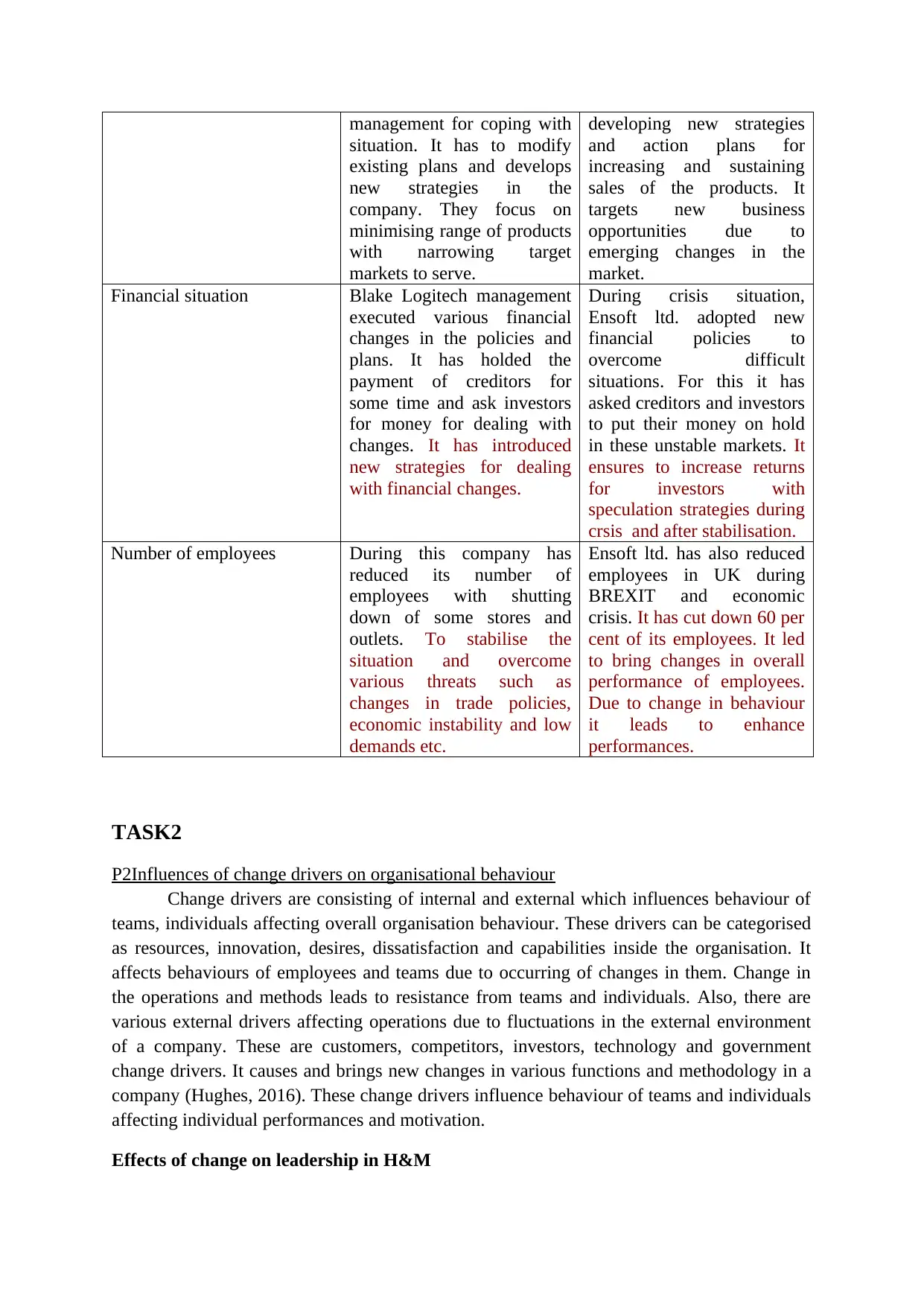
management for coping with
situation. It has to modify
existing plans and develops
new strategies in the
company. They focus on
minimising range of products
with narrowing target
markets to serve.
developing new strategies
and action plans for
increasing and sustaining
sales of the products. It
targets new business
opportunities due to
emerging changes in the
market.
Financial situation Blake Logitech management
executed various financial
changes in the policies and
plans. It has holded the
payment of creditors for
some time and ask investors
for money for dealing with
changes. It has introduced
new strategies for dealing
with financial changes.
During crisis situation,
Ensoft ltd. adopted new
financial policies to
overcome difficult
situations. For this it has
asked creditors and investors
to put their money on hold
in these unstable markets. It
ensures to increase returns
for investors with
speculation strategies during
crsis and after stabilisation.
Number of employees During this company has
reduced its number of
employees with shutting
down of some stores and
outlets. To stabilise the
situation and overcome
various threats such as
changes in trade policies,
economic instability and low
demands etc.
Ensoft ltd. has also reduced
employees in UK during
BREXIT and economic
crisis. It has cut down 60 per
cent of its employees. It led
to bring changes in overall
performance of employees.
Due to change in behaviour
it leads to enhance
performances.
TASK2
P2Influences of change drivers on organisational behaviour
Change drivers are consisting of internal and external which influences behaviour of
teams, individuals affecting overall organisation behaviour. These drivers can be categorised
as resources, innovation, desires, dissatisfaction and capabilities inside the organisation. It
affects behaviours of employees and teams due to occurring of changes in them. Change in
the operations and methods leads to resistance from teams and individuals. Also, there are
various external drivers affecting operations due to fluctuations in the external environment
of a company. These are customers, competitors, investors, technology and government
change drivers. It causes and brings new changes in various functions and methodology in a
company (Hughes, 2016). These change drivers influence behaviour of teams and individuals
affecting individual performances and motivation.
Effects of change on leadership in H&M
situation. It has to modify
existing plans and develops
new strategies in the
company. They focus on
minimising range of products
with narrowing target
markets to serve.
developing new strategies
and action plans for
increasing and sustaining
sales of the products. It
targets new business
opportunities due to
emerging changes in the
market.
Financial situation Blake Logitech management
executed various financial
changes in the policies and
plans. It has holded the
payment of creditors for
some time and ask investors
for money for dealing with
changes. It has introduced
new strategies for dealing
with financial changes.
During crisis situation,
Ensoft ltd. adopted new
financial policies to
overcome difficult
situations. For this it has
asked creditors and investors
to put their money on hold
in these unstable markets. It
ensures to increase returns
for investors with
speculation strategies during
crsis and after stabilisation.
Number of employees During this company has
reduced its number of
employees with shutting
down of some stores and
outlets. To stabilise the
situation and overcome
various threats such as
changes in trade policies,
economic instability and low
demands etc.
Ensoft ltd. has also reduced
employees in UK during
BREXIT and economic
crisis. It has cut down 60 per
cent of its employees. It led
to bring changes in overall
performance of employees.
Due to change in behaviour
it leads to enhance
performances.
TASK2
P2Influences of change drivers on organisational behaviour
Change drivers are consisting of internal and external which influences behaviour of
teams, individuals affecting overall organisation behaviour. These drivers can be categorised
as resources, innovation, desires, dissatisfaction and capabilities inside the organisation. It
affects behaviours of employees and teams due to occurring of changes in them. Change in
the operations and methods leads to resistance from teams and individuals. Also, there are
various external drivers affecting operations due to fluctuations in the external environment
of a company. These are customers, competitors, investors, technology and government
change drivers. It causes and brings new changes in various functions and methodology in a
company (Hughes, 2016). These change drivers influence behaviour of teams and individuals
affecting individual performances and motivation.
Effects of change on leadership in H&M
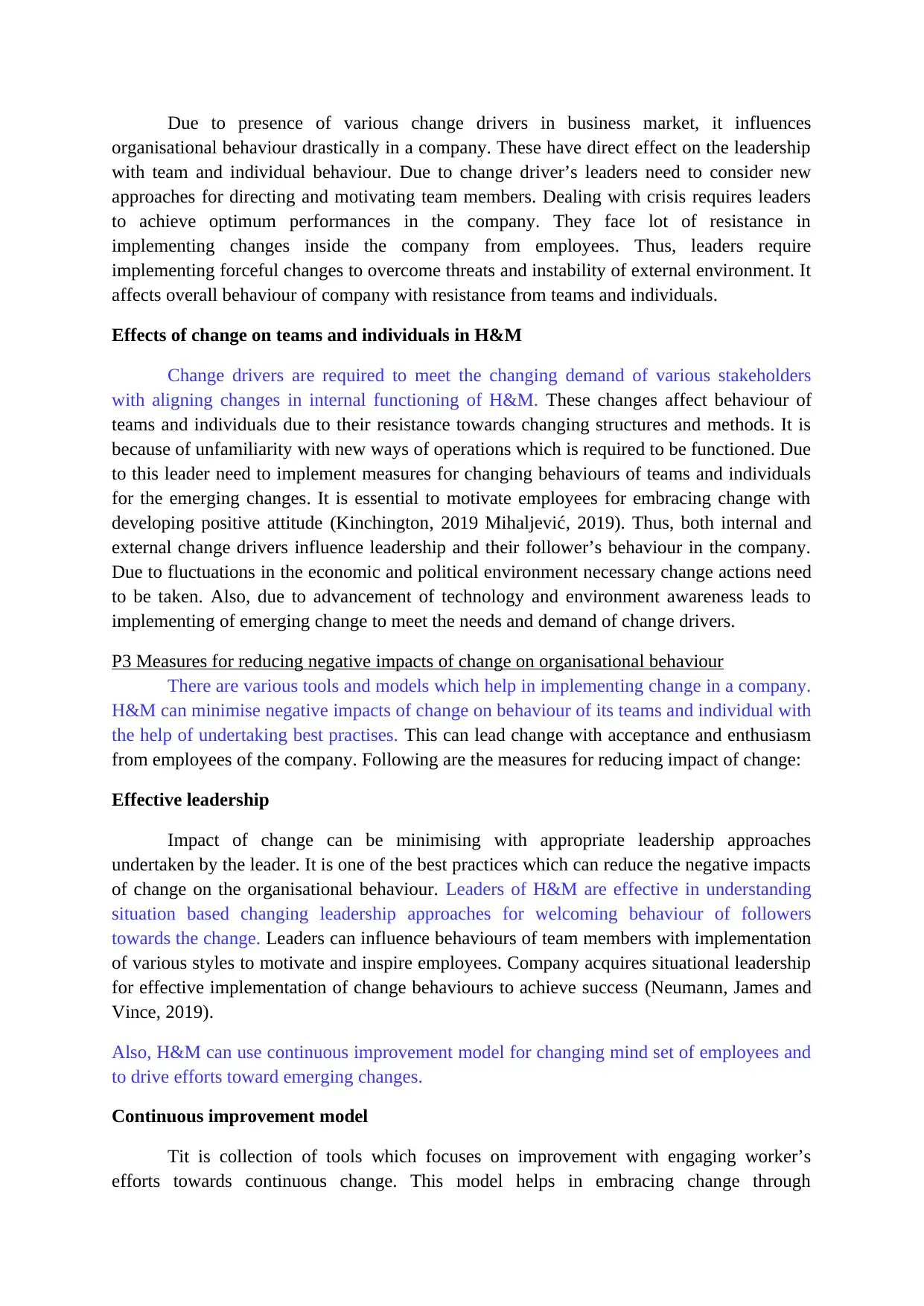
Due to presence of various change drivers in business market, it influences
organisational behaviour drastically in a company. These have direct effect on the leadership
with team and individual behaviour. Due to change driver’s leaders need to consider new
approaches for directing and motivating team members. Dealing with crisis requires leaders
to achieve optimum performances in the company. They face lot of resistance in
implementing changes inside the company from employees. Thus, leaders require
implementing forceful changes to overcome threats and instability of external environment. It
affects overall behaviour of company with resistance from teams and individuals.
Effects of change on teams and individuals in H&M
Change drivers are required to meet the changing demand of various stakeholders
with aligning changes in internal functioning of H&M. These changes affect behaviour of
teams and individuals due to their resistance towards changing structures and methods. It is
because of unfamiliarity with new ways of operations which is required to be functioned. Due
to this leader need to implement measures for changing behaviours of teams and individuals
for the emerging changes. It is essential to motivate employees for embracing change with
developing positive attitude (Kinchington, 2019 Mihaljević, 2019). Thus, both internal and
external change drivers influence leadership and their follower’s behaviour in the company.
Due to fluctuations in the economic and political environment necessary change actions need
to be taken. Also, due to advancement of technology and environment awareness leads to
implementing of emerging change to meet the needs and demand of change drivers.
P3 Measures for reducing negative impacts of change on organisational behaviour
There are various tools and models which help in implementing change in a company.
H&M can minimise negative impacts of change on behaviour of its teams and individual with
the help of undertaking best practises. This can lead change with acceptance and enthusiasm
from employees of the company. Following are the measures for reducing impact of change:
Effective leadership
Impact of change can be minimising with appropriate leadership approaches
undertaken by the leader. It is one of the best practices which can reduce the negative impacts
of change on the organisational behaviour. Leaders of H&M are effective in understanding
situation based changing leadership approaches for welcoming behaviour of followers
towards the change. Leaders can influence behaviours of team members with implementation
of various styles to motivate and inspire employees. Company acquires situational leadership
for effective implementation of change behaviours to achieve success (Neumann, James and
Vince, 2019).
Also, H&M can use continuous improvement model for changing mind set of employees and
to drive efforts toward emerging changes.
Continuous improvement model
Tit is collection of tools which focuses on improvement with engaging worker’s
efforts towards continuous change. This model helps in embracing change through
organisational behaviour drastically in a company. These have direct effect on the leadership
with team and individual behaviour. Due to change driver’s leaders need to consider new
approaches for directing and motivating team members. Dealing with crisis requires leaders
to achieve optimum performances in the company. They face lot of resistance in
implementing changes inside the company from employees. Thus, leaders require
implementing forceful changes to overcome threats and instability of external environment. It
affects overall behaviour of company with resistance from teams and individuals.
Effects of change on teams and individuals in H&M
Change drivers are required to meet the changing demand of various stakeholders
with aligning changes in internal functioning of H&M. These changes affect behaviour of
teams and individuals due to their resistance towards changing structures and methods. It is
because of unfamiliarity with new ways of operations which is required to be functioned. Due
to this leader need to implement measures for changing behaviours of teams and individuals
for the emerging changes. It is essential to motivate employees for embracing change with
developing positive attitude (Kinchington, 2019 Mihaljević, 2019). Thus, both internal and
external change drivers influence leadership and their follower’s behaviour in the company.
Due to fluctuations in the economic and political environment necessary change actions need
to be taken. Also, due to advancement of technology and environment awareness leads to
implementing of emerging change to meet the needs and demand of change drivers.
P3 Measures for reducing negative impacts of change on organisational behaviour
There are various tools and models which help in implementing change in a company.
H&M can minimise negative impacts of change on behaviour of its teams and individual with
the help of undertaking best practises. This can lead change with acceptance and enthusiasm
from employees of the company. Following are the measures for reducing impact of change:
Effective leadership
Impact of change can be minimising with appropriate leadership approaches
undertaken by the leader. It is one of the best practices which can reduce the negative impacts
of change on the organisational behaviour. Leaders of H&M are effective in understanding
situation based changing leadership approaches for welcoming behaviour of followers
towards the change. Leaders can influence behaviours of team members with implementation
of various styles to motivate and inspire employees. Company acquires situational leadership
for effective implementation of change behaviours to achieve success (Neumann, James and
Vince, 2019).
Also, H&M can use continuous improvement model for changing mind set of employees and
to drive efforts toward emerging changes.
Continuous improvement model
Tit is collection of tools which focuses on improvement with engaging worker’s
efforts towards continuous change. This model helps in embracing change through
⊘ This is a preview!⊘
Do you want full access?
Subscribe today to unlock all pages.

Trusted by 1+ million students worldwide
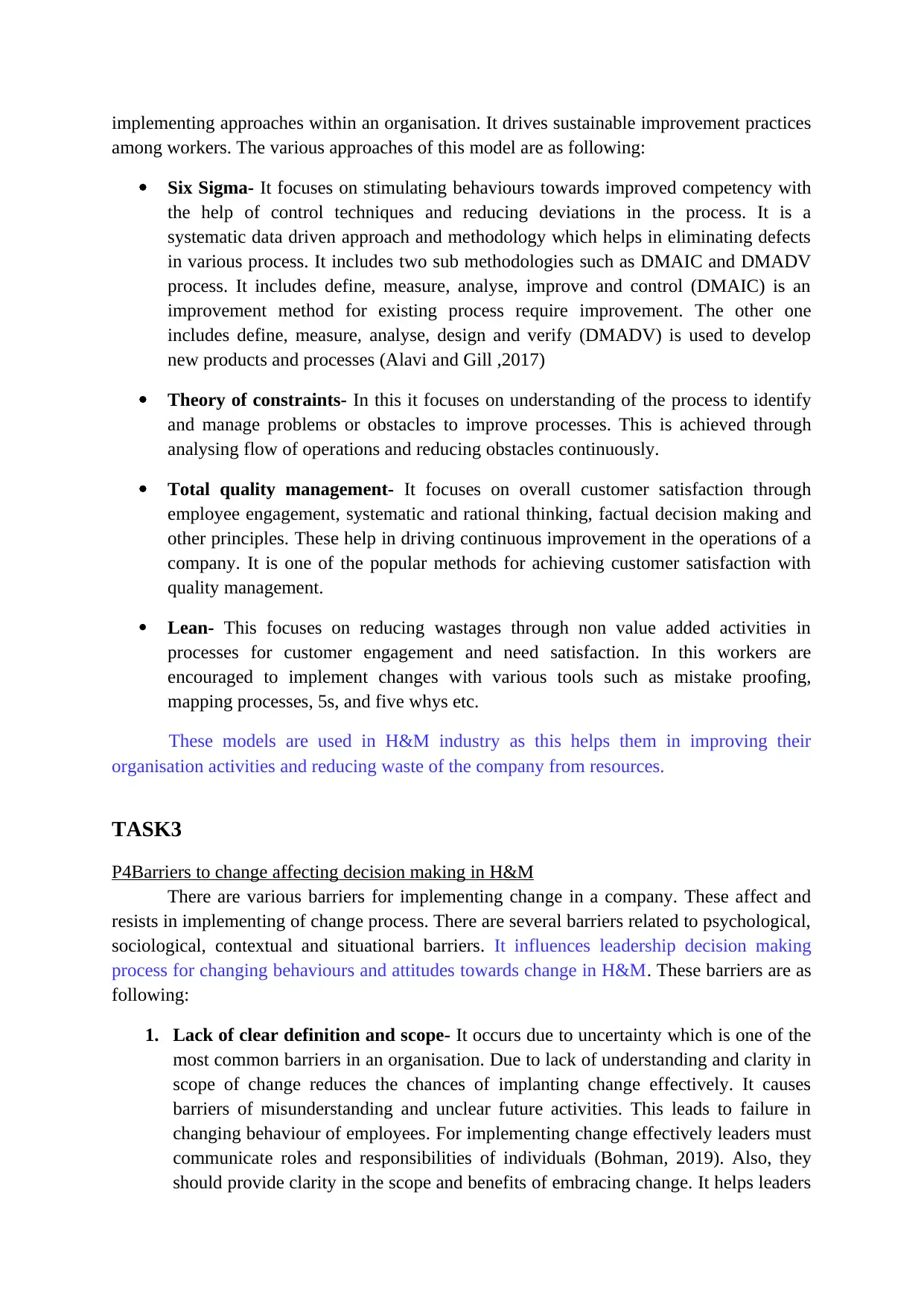
implementing approaches within an organisation. It drives sustainable improvement practices
among workers. The various approaches of this model are as following:
Six Sigma- It focuses on stimulating behaviours towards improved competency with
the help of control techniques and reducing deviations in the process. It is a
systematic data driven approach and methodology which helps in eliminating defects
in various process. It includes two sub methodologies such as DMAIC and DMADV
process. It includes define, measure, analyse, improve and control (DMAIC) is an
improvement method for existing process require improvement. The other one
includes define, measure, analyse, design and verify (DMADV) is used to develop
new products and processes (Alavi and Gill ,2017)
Theory of constraints- In this it focuses on understanding of the process to identify
and manage problems or obstacles to improve processes. This is achieved through
analysing flow of operations and reducing obstacles continuously.
Total quality management- It focuses on overall customer satisfaction through
employee engagement, systematic and rational thinking, factual decision making and
other principles. These help in driving continuous improvement in the operations of a
company. It is one of the popular methods for achieving customer satisfaction with
quality management.
Lean- This focuses on reducing wastages through non value added activities in
processes for customer engagement and need satisfaction. In this workers are
encouraged to implement changes with various tools such as mistake proofing,
mapping processes, 5s, and five whys etc.
These models are used in H&M industry as this helps them in improving their
organisation activities and reducing waste of the company from resources.
TASK3
P4Barriers to change affecting decision making in H&M
There are various barriers for implementing change in a company. These affect and
resists in implementing of change process. There are several barriers related to psychological,
sociological, contextual and situational barriers. It influences leadership decision making
process for changing behaviours and attitudes towards change in H&M. These barriers are as
following:
1. Lack of clear definition and scope- It occurs due to uncertainty which is one of the
most common barriers in an organisation. Due to lack of understanding and clarity in
scope of change reduces the chances of implanting change effectively. It causes
barriers of misunderstanding and unclear future activities. This leads to failure in
changing behaviour of employees. For implementing change effectively leaders must
communicate roles and responsibilities of individuals (Bohman, 2019). Also, they
should provide clarity in the scope and benefits of embracing change. It helps leaders
among workers. The various approaches of this model are as following:
Six Sigma- It focuses on stimulating behaviours towards improved competency with
the help of control techniques and reducing deviations in the process. It is a
systematic data driven approach and methodology which helps in eliminating defects
in various process. It includes two sub methodologies such as DMAIC and DMADV
process. It includes define, measure, analyse, improve and control (DMAIC) is an
improvement method for existing process require improvement. The other one
includes define, measure, analyse, design and verify (DMADV) is used to develop
new products and processes (Alavi and Gill ,2017)
Theory of constraints- In this it focuses on understanding of the process to identify
and manage problems or obstacles to improve processes. This is achieved through
analysing flow of operations and reducing obstacles continuously.
Total quality management- It focuses on overall customer satisfaction through
employee engagement, systematic and rational thinking, factual decision making and
other principles. These help in driving continuous improvement in the operations of a
company. It is one of the popular methods for achieving customer satisfaction with
quality management.
Lean- This focuses on reducing wastages through non value added activities in
processes for customer engagement and need satisfaction. In this workers are
encouraged to implement changes with various tools such as mistake proofing,
mapping processes, 5s, and five whys etc.
These models are used in H&M industry as this helps them in improving their
organisation activities and reducing waste of the company from resources.
TASK3
P4Barriers to change affecting decision making in H&M
There are various barriers for implementing change in a company. These affect and
resists in implementing of change process. There are several barriers related to psychological,
sociological, contextual and situational barriers. It influences leadership decision making
process for changing behaviours and attitudes towards change in H&M. These barriers are as
following:
1. Lack of clear definition and scope- It occurs due to uncertainty which is one of the
most common barriers in an organisation. Due to lack of understanding and clarity in
scope of change reduces the chances of implanting change effectively. It causes
barriers of misunderstanding and unclear future activities. This leads to failure in
changing behaviour of employees. For implementing change effectively leaders must
communicate roles and responsibilities of individuals (Bohman, 2019). Also, they
should provide clarity in the scope and benefits of embracing change. It helps leaders
Paraphrase This Document
Need a fresh take? Get an instant paraphrase of this document with our AI Paraphraser
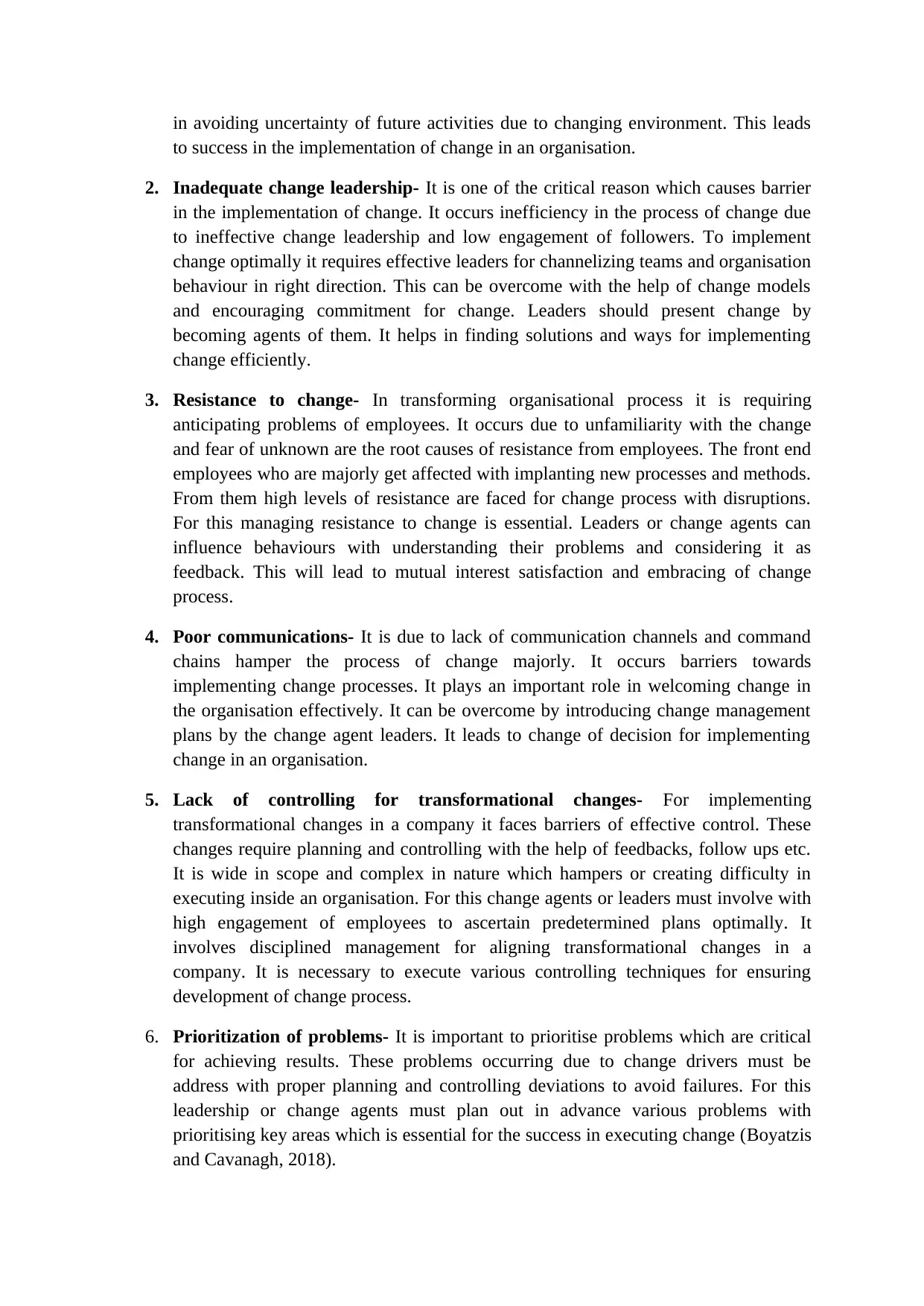
in avoiding uncertainty of future activities due to changing environment. This leads
to success in the implementation of change in an organisation.
2. Inadequate change leadership- It is one of the critical reason which causes barrier
in the implementation of change. It occurs inefficiency in the process of change due
to ineffective change leadership and low engagement of followers. To implement
change optimally it requires effective leaders for channelizing teams and organisation
behaviour in right direction. This can be overcome with the help of change models
and encouraging commitment for change. Leaders should present change by
becoming agents of them. It helps in finding solutions and ways for implementing
change efficiently.
3. Resistance to change- In transforming organisational process it is requiring
anticipating problems of employees. It occurs due to unfamiliarity with the change
and fear of unknown are the root causes of resistance from employees. The front end
employees who are majorly get affected with implanting new processes and methods.
From them high levels of resistance are faced for change process with disruptions.
For this managing resistance to change is essential. Leaders or change agents can
influence behaviours with understanding their problems and considering it as
feedback. This will lead to mutual interest satisfaction and embracing of change
process.
4. Poor communications- It is due to lack of communication channels and command
chains hamper the process of change majorly. It occurs barriers towards
implementing change processes. It plays an important role in welcoming change in
the organisation effectively. It can be overcome by introducing change management
plans by the change agent leaders. It leads to change of decision for implementing
change in an organisation.
5. Lack of controlling for transformational changes- For implementing
transformational changes in a company it faces barriers of effective control. These
changes require planning and controlling with the help of feedbacks, follow ups etc.
It is wide in scope and complex in nature which hampers or creating difficulty in
executing inside an organisation. For this change agents or leaders must involve with
high engagement of employees to ascertain predetermined plans optimally. It
involves disciplined management for aligning transformational changes in a
company. It is necessary to execute various controlling techniques for ensuring
development of change process.
6. Prioritization of problems- It is important to prioritise problems which are critical
for achieving results. These problems occurring due to change drivers must be
address with proper planning and controlling deviations to avoid failures. For this
leadership or change agents must plan out in advance various problems with
prioritising key areas which is essential for the success in executing change (Boyatzis
and Cavanagh, 2018).
to success in the implementation of change in an organisation.
2. Inadequate change leadership- It is one of the critical reason which causes barrier
in the implementation of change. It occurs inefficiency in the process of change due
to ineffective change leadership and low engagement of followers. To implement
change optimally it requires effective leaders for channelizing teams and organisation
behaviour in right direction. This can be overcome with the help of change models
and encouraging commitment for change. Leaders should present change by
becoming agents of them. It helps in finding solutions and ways for implementing
change efficiently.
3. Resistance to change- In transforming organisational process it is requiring
anticipating problems of employees. It occurs due to unfamiliarity with the change
and fear of unknown are the root causes of resistance from employees. The front end
employees who are majorly get affected with implanting new processes and methods.
From them high levels of resistance are faced for change process with disruptions.
For this managing resistance to change is essential. Leaders or change agents can
influence behaviours with understanding their problems and considering it as
feedback. This will lead to mutual interest satisfaction and embracing of change
process.
4. Poor communications- It is due to lack of communication channels and command
chains hamper the process of change majorly. It occurs barriers towards
implementing change processes. It plays an important role in welcoming change in
the organisation effectively. It can be overcome by introducing change management
plans by the change agent leaders. It leads to change of decision for implementing
change in an organisation.
5. Lack of controlling for transformational changes- For implementing
transformational changes in a company it faces barriers of effective control. These
changes require planning and controlling with the help of feedbacks, follow ups etc.
It is wide in scope and complex in nature which hampers or creating difficulty in
executing inside an organisation. For this change agents or leaders must involve with
high engagement of employees to ascertain predetermined plans optimally. It
involves disciplined management for aligning transformational changes in a
company. It is necessary to execute various controlling techniques for ensuring
development of change process.
6. Prioritization of problems- It is important to prioritise problems which are critical
for achieving results. These problems occurring due to change drivers must be
address with proper planning and controlling deviations to avoid failures. For this
leadership or change agents must plan out in advance various problems with
prioritising key areas which is essential for the success in executing change (Boyatzis
and Cavanagh, 2018).
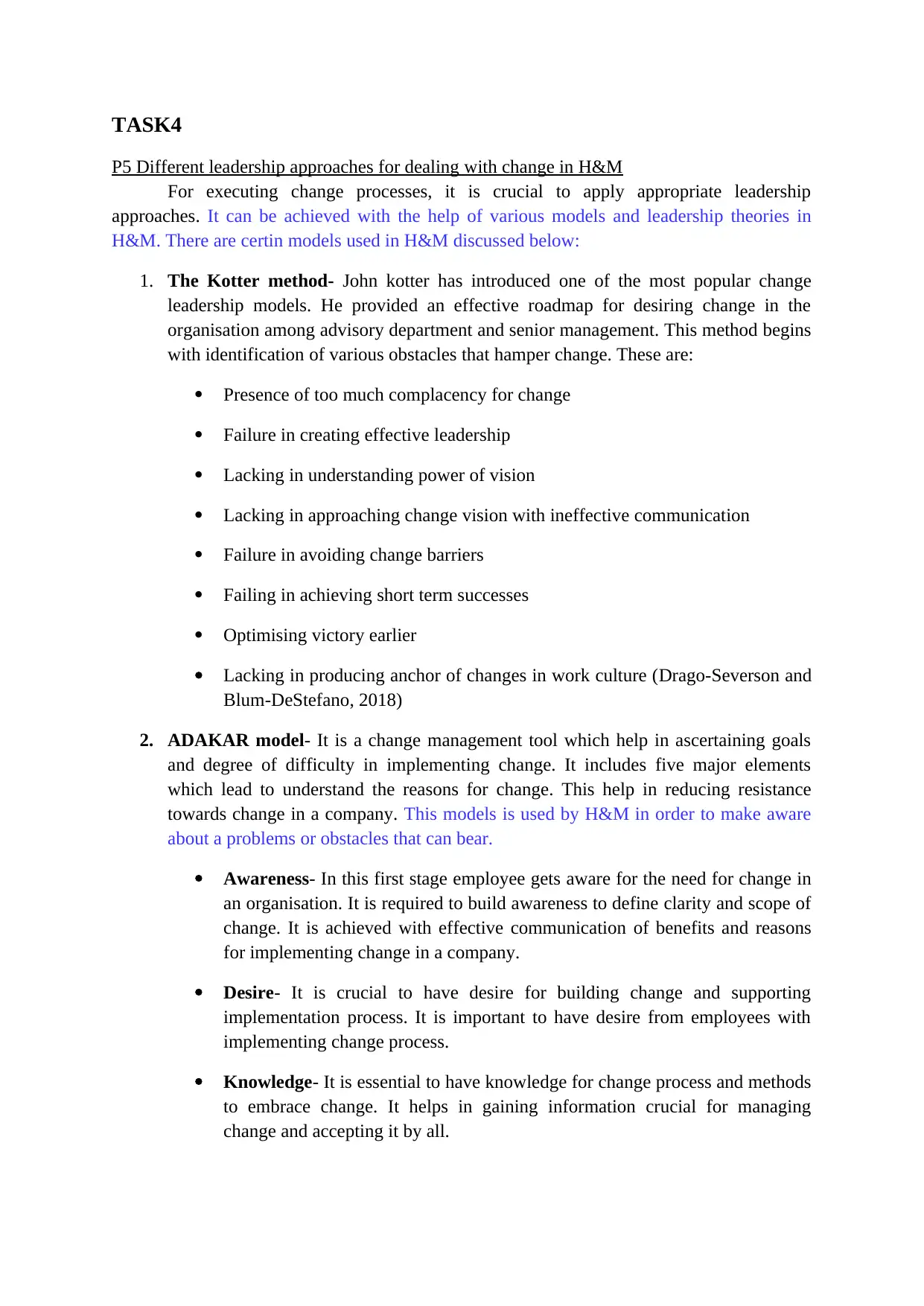
TASK4
P5 Different leadership approaches for dealing with change in H&M
For executing change processes, it is crucial to apply appropriate leadership
approaches. It can be achieved with the help of various models and leadership theories in
H&M. There are certin models used in H&M discussed below:
1. The Kotter method- John kotter has introduced one of the most popular change
leadership models. He provided an effective roadmap for desiring change in the
organisation among advisory department and senior management. This method begins
with identification of various obstacles that hamper change. These are:
Presence of too much complacency for change
Failure in creating effective leadership
Lacking in understanding power of vision
Lacking in approaching change vision with ineffective communication
Failure in avoiding change barriers
Failing in achieving short term successes
Optimising victory earlier
Lacking in producing anchor of changes in work culture (Drago-Severson and
Blum-DeStefano, 2018)
2. ADAKAR model- It is a change management tool which help in ascertaining goals
and degree of difficulty in implementing change. It includes five major elements
which lead to understand the reasons for change. This help in reducing resistance
towards change in a company. This models is used by H&M in order to make aware
about a problems or obstacles that can bear.
Awareness- In this first stage employee gets aware for the need for change in
an organisation. It is required to build awareness to define clarity and scope of
change. It is achieved with effective communication of benefits and reasons
for implementing change in a company.
Desire- It is crucial to have desire for building change and supporting
implementation process. It is important to have desire from employees with
implementing change process.
Knowledge- It is essential to have knowledge for change process and methods
to embrace change. It helps in gaining information crucial for managing
change and accepting it by all.
P5 Different leadership approaches for dealing with change in H&M
For executing change processes, it is crucial to apply appropriate leadership
approaches. It can be achieved with the help of various models and leadership theories in
H&M. There are certin models used in H&M discussed below:
1. The Kotter method- John kotter has introduced one of the most popular change
leadership models. He provided an effective roadmap for desiring change in the
organisation among advisory department and senior management. This method begins
with identification of various obstacles that hamper change. These are:
Presence of too much complacency for change
Failure in creating effective leadership
Lacking in understanding power of vision
Lacking in approaching change vision with ineffective communication
Failure in avoiding change barriers
Failing in achieving short term successes
Optimising victory earlier
Lacking in producing anchor of changes in work culture (Drago-Severson and
Blum-DeStefano, 2018)
2. ADAKAR model- It is a change management tool which help in ascertaining goals
and degree of difficulty in implementing change. It includes five major elements
which lead to understand the reasons for change. This help in reducing resistance
towards change in a company. This models is used by H&M in order to make aware
about a problems or obstacles that can bear.
Awareness- In this first stage employee gets aware for the need for change in
an organisation. It is required to build awareness to define clarity and scope of
change. It is achieved with effective communication of benefits and reasons
for implementing change in a company.
Desire- It is crucial to have desire for building change and supporting
implementation process. It is important to have desire from employees with
implementing change process.
Knowledge- It is essential to have knowledge for change process and methods
to embrace change. It helps in gaining information crucial for managing
change and accepting it by all.
⊘ This is a preview!⊘
Do you want full access?
Subscribe today to unlock all pages.

Trusted by 1+ million students worldwide
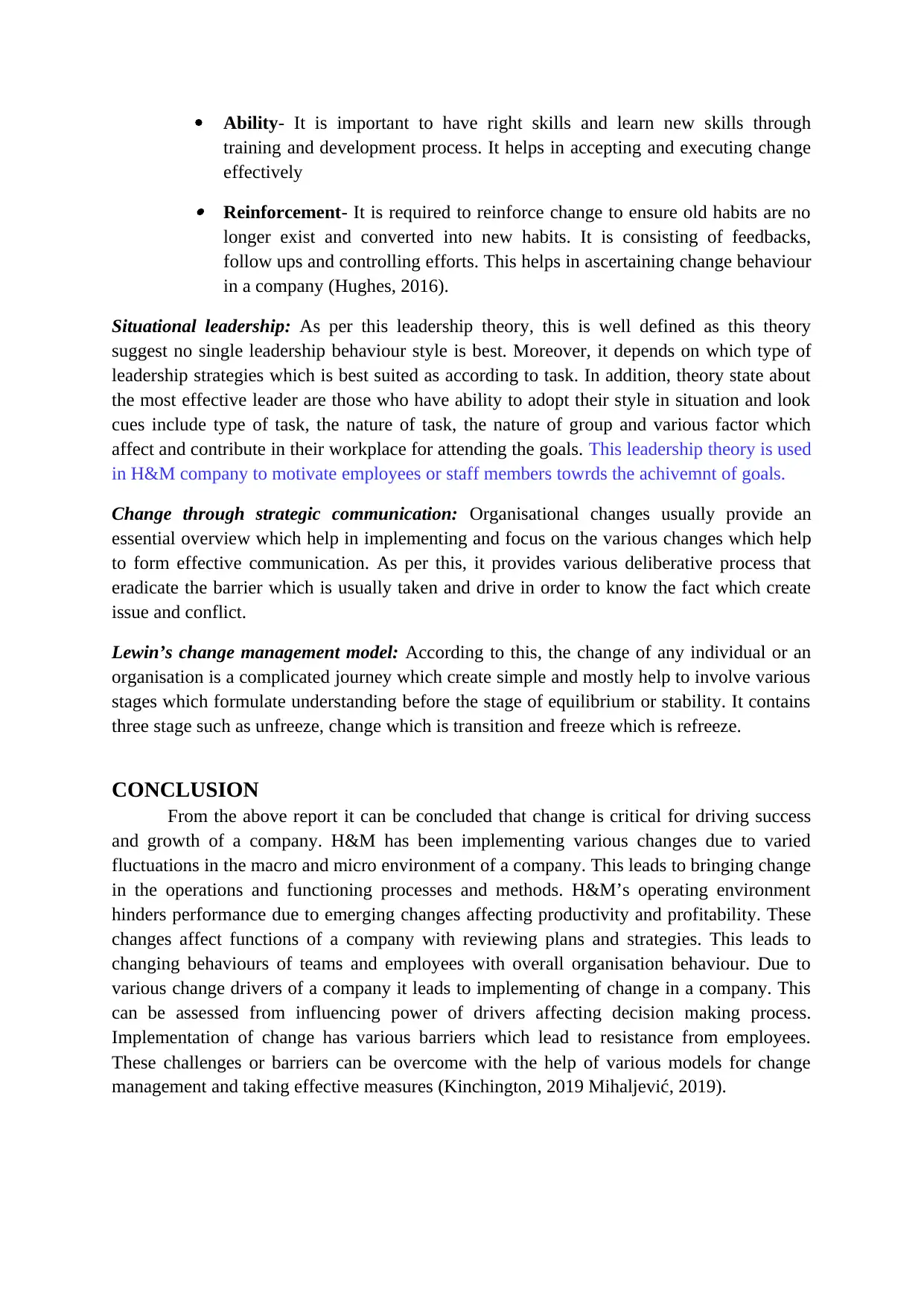
Ability- It is important to have right skills and learn new skills through
training and development process. It helps in accepting and executing change
effectively
Reinforcement- It is required to reinforce change to ensure old habits are no
longer exist and converted into new habits. It is consisting of feedbacks,
follow ups and controlling efforts. This helps in ascertaining change behaviour
in a company (Hughes, 2016).
Situational leadership: As per this leadership theory, this is well defined as this theory
suggest no single leadership behaviour style is best. Moreover, it depends on which type of
leadership strategies which is best suited as according to task. In addition, theory state about
the most effective leader are those who have ability to adopt their style in situation and look
cues include type of task, the nature of task, the nature of group and various factor which
affect and contribute in their workplace for attending the goals. This leadership theory is used
in H&M company to motivate employees or staff members towrds the achivemnt of goals.
Change through strategic communication: Organisational changes usually provide an
essential overview which help in implementing and focus on the various changes which help
to form effective communication. As per this, it provides various deliberative process that
eradicate the barrier which is usually taken and drive in order to know the fact which create
issue and conflict.
Lewin’s change management model: According to this, the change of any individual or an
organisation is a complicated journey which create simple and mostly help to involve various
stages which formulate understanding before the stage of equilibrium or stability. It contains
three stage such as unfreeze, change which is transition and freeze which is refreeze.
CONCLUSION
From the above report it can be concluded that change is critical for driving success
and growth of a company. H&M has been implementing various changes due to varied
fluctuations in the macro and micro environment of a company. This leads to bringing change
in the operations and functioning processes and methods. H&M’s operating environment
hinders performance due to emerging changes affecting productivity and profitability. These
changes affect functions of a company with reviewing plans and strategies. This leads to
changing behaviours of teams and employees with overall organisation behaviour. Due to
various change drivers of a company it leads to implementing of change in a company. This
can be assessed from influencing power of drivers affecting decision making process.
Implementation of change has various barriers which lead to resistance from employees.
These challenges or barriers can be overcome with the help of various models for change
management and taking effective measures (Kinchington, 2019 Mihaljević, 2019).
training and development process. It helps in accepting and executing change
effectively
Reinforcement- It is required to reinforce change to ensure old habits are no
longer exist and converted into new habits. It is consisting of feedbacks,
follow ups and controlling efforts. This helps in ascertaining change behaviour
in a company (Hughes, 2016).
Situational leadership: As per this leadership theory, this is well defined as this theory
suggest no single leadership behaviour style is best. Moreover, it depends on which type of
leadership strategies which is best suited as according to task. In addition, theory state about
the most effective leader are those who have ability to adopt their style in situation and look
cues include type of task, the nature of task, the nature of group and various factor which
affect and contribute in their workplace for attending the goals. This leadership theory is used
in H&M company to motivate employees or staff members towrds the achivemnt of goals.
Change through strategic communication: Organisational changes usually provide an
essential overview which help in implementing and focus on the various changes which help
to form effective communication. As per this, it provides various deliberative process that
eradicate the barrier which is usually taken and drive in order to know the fact which create
issue and conflict.
Lewin’s change management model: According to this, the change of any individual or an
organisation is a complicated journey which create simple and mostly help to involve various
stages which formulate understanding before the stage of equilibrium or stability. It contains
three stage such as unfreeze, change which is transition and freeze which is refreeze.
CONCLUSION
From the above report it can be concluded that change is critical for driving success
and growth of a company. H&M has been implementing various changes due to varied
fluctuations in the macro and micro environment of a company. This leads to bringing change
in the operations and functioning processes and methods. H&M’s operating environment
hinders performance due to emerging changes affecting productivity and profitability. These
changes affect functions of a company with reviewing plans and strategies. This leads to
changing behaviours of teams and employees with overall organisation behaviour. Due to
various change drivers of a company it leads to implementing of change in a company. This
can be assessed from influencing power of drivers affecting decision making process.
Implementation of change has various barriers which lead to resistance from employees.
These challenges or barriers can be overcome with the help of various models for change
management and taking effective measures (Kinchington, 2019 Mihaljević, 2019).
Paraphrase This Document
Need a fresh take? Get an instant paraphrase of this document with our AI Paraphraser
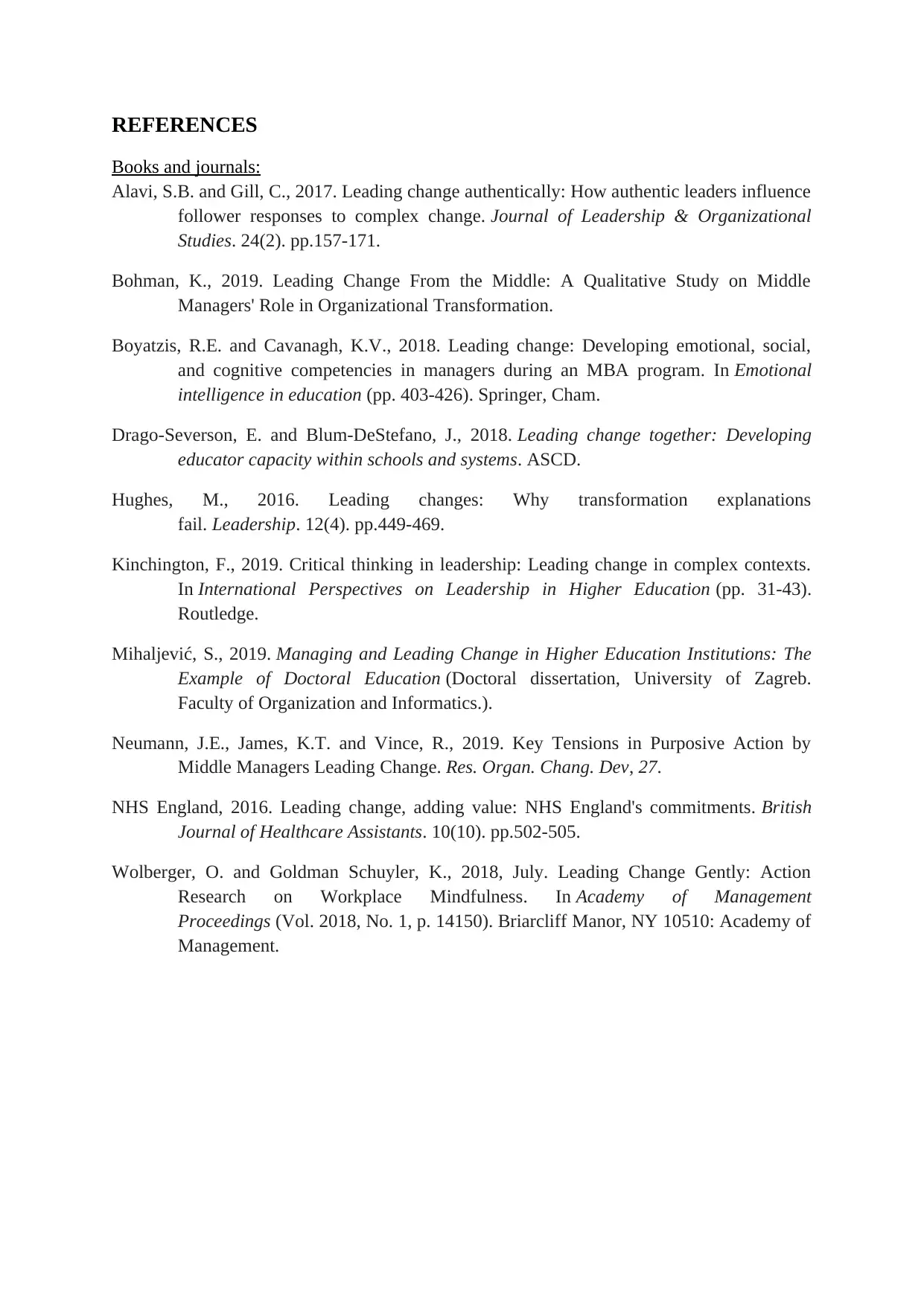
REFERENCES
Books and journals:
Alavi, S.B. and Gill, C., 2017. Leading change authentically: How authentic leaders influence
follower responses to complex change. Journal of Leadership & Organizational
Studies. 24(2). pp.157-171.
Bohman, K., 2019. Leading Change From the Middle: A Qualitative Study on Middle
Managers' Role in Organizational Transformation.
Boyatzis, R.E. and Cavanagh, K.V., 2018. Leading change: Developing emotional, social,
and cognitive competencies in managers during an MBA program. In Emotional
intelligence in education (pp. 403-426). Springer, Cham.
Drago-Severson, E. and Blum-DeStefano, J., 2018. Leading change together: Developing
educator capacity within schools and systems. ASCD.
Hughes, M., 2016. Leading changes: Why transformation explanations
fail. Leadership. 12(4). pp.449-469.
Kinchington, F., 2019. Critical thinking in leadership: Leading change in complex contexts.
In International Perspectives on Leadership in Higher Education (pp. 31-43).
Routledge.
Mihaljević, S., 2019. Managing and Leading Change in Higher Education Institutions: The
Example of Doctoral Education (Doctoral dissertation, University of Zagreb.
Faculty of Organization and Informatics.).
Neumann, J.E., James, K.T. and Vince, R., 2019. Key Tensions in Purposive Action by
Middle Managers Leading Change. Res. Organ. Chang. Dev, 27.
NHS England, 2016. Leading change, adding value: NHS England's commitments. British
Journal of Healthcare Assistants. 10(10). pp.502-505.
Wolberger, O. and Goldman Schuyler, K., 2018, July. Leading Change Gently: Action
Research on Workplace Mindfulness. In Academy of Management
Proceedings (Vol. 2018, No. 1, p. 14150). Briarcliff Manor, NY 10510: Academy of
Management.
Books and journals:
Alavi, S.B. and Gill, C., 2017. Leading change authentically: How authentic leaders influence
follower responses to complex change. Journal of Leadership & Organizational
Studies. 24(2). pp.157-171.
Bohman, K., 2019. Leading Change From the Middle: A Qualitative Study on Middle
Managers' Role in Organizational Transformation.
Boyatzis, R.E. and Cavanagh, K.V., 2018. Leading change: Developing emotional, social,
and cognitive competencies in managers during an MBA program. In Emotional
intelligence in education (pp. 403-426). Springer, Cham.
Drago-Severson, E. and Blum-DeStefano, J., 2018. Leading change together: Developing
educator capacity within schools and systems. ASCD.
Hughes, M., 2016. Leading changes: Why transformation explanations
fail. Leadership. 12(4). pp.449-469.
Kinchington, F., 2019. Critical thinking in leadership: Leading change in complex contexts.
In International Perspectives on Leadership in Higher Education (pp. 31-43).
Routledge.
Mihaljević, S., 2019. Managing and Leading Change in Higher Education Institutions: The
Example of Doctoral Education (Doctoral dissertation, University of Zagreb.
Faculty of Organization and Informatics.).
Neumann, J.E., James, K.T. and Vince, R., 2019. Key Tensions in Purposive Action by
Middle Managers Leading Change. Res. Organ. Chang. Dev, 27.
NHS England, 2016. Leading change, adding value: NHS England's commitments. British
Journal of Healthcare Assistants. 10(10). pp.502-505.
Wolberger, O. and Goldman Schuyler, K., 2018, July. Leading Change Gently: Action
Research on Workplace Mindfulness. In Academy of Management
Proceedings (Vol. 2018, No. 1, p. 14150). Briarcliff Manor, NY 10510: Academy of
Management.
1 out of 11
Related Documents
Your All-in-One AI-Powered Toolkit for Academic Success.
+13062052269
info@desklib.com
Available 24*7 on WhatsApp / Email
![[object Object]](/_next/static/media/star-bottom.7253800d.svg)
Unlock your academic potential
Copyright © 2020–2025 A2Z Services. All Rights Reserved. Developed and managed by ZUCOL.




